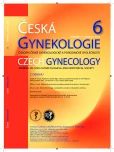Incidence of infection of newborns of GBS positive mothers in relationto peripartal antibiotic prophylaxis or mode of delivery
Authors:
M. Szetei 1; I. Borek 1; V. Unzeitig 2; V. Marček 3
Authors‘ workplace:
Neonatologické oddělení FN, Brno, primár MUDr. I. Borek
1; Gynekologicko-porodnická klinika FN, Brno, prednosta prof. MUDr. P. Ventruba, DrSc., MBA
2; Fakulta sociálních studií, Katedra psychologie MU, Brno, vedúci katedry prof. PhDr. Z. Vybíral, Ph. D.
3
Published in:
Ceska Gynekol 2012; 77(6): 492-497
Overview
Objective:
To evaluate the effectiveness of antibiotic prophylaxis given to GBS positive women in time of delivery on incidence of infection of their newborns. To find whether is the infection of the newborn correlated with the mode of delivery or with the length of PROM.
Design:
Prospective cohort study.
Study sample:
Of all 6415 live born newborns born in between May 2010 to April 2011 at Faculty hospital Brno we selected only those whose mothers had positive GBS vaginal cultivation at time of delivery, which meant 1115 newborns.
Methods:
We compared the incidence of complications resulting from infection between the newborns divided into groups based on time of administration of antibiotic prophylaxis (adequate, inadequate, none) or by mode of delivery (vaginal, cesarean without PROM, cesarean with PROM).
Results:
In our 1115 newborns peripartal antibiotic prophylaxis was given adequately in 355 (31.84%) cases, inadequately in 609 (54.62%) cases, none was given in 151 (13.54%) cases. Vaginal delivery was in 869 (77,94%) cases, cesarean delivery with PROM in 146 (13.09%) cases, cesarean delivery without PROM in 100 (8.97%) cases. Complications due to infection was seen in 14 (1.26%) newborns, cultivation confirmation as GBS was in 2 (0.18%) newborns. There were no deaths of newborns according to the infection caused by GBS
Conclusion:
Due to small amount of cases with GBS infection within our group we could not statistically prove the effect of antibiotic prophylaxis, nor could we associate our results with specific mode of delivery. The results seen in our study show an incidence of early-onset sepsis (regardless of agent) 2.18/1000 live born; invasive GBS sepsis: 0.31/1000 live born; GBS colonization of pregnant women 17.4%.
Key words:
infection, newborn, GBS, SAG, antibiotic prophylaxis, screening.
Sources
1. Bany-Mohammed, FM. Sepsis. In Gomella, TL. (Ed.). Neonatology: Management, Procedures, On-Call Problems, Diseases, and Drugs. 6th ed. New York: McGraw-Hill Companies, 2009, p. 665–672.
2. Biringer, K., Biskupská Boďová, K., Haško, M., et al. Streptokoky skupiny B v perinatológii. Čes Gynek, 2010, 75, 5, s. 435–438.
3. IBM. SPSS Statistics. http://www-01.ibm.com/software/analytics/spss/products/statistics/
4. Macko, J., Zach, J. Postup péče o novorozence Streptococcus agalactiae (GBS) negativních, pozitivních nebo nevyšetřených matek. Praha: Česká neonatologická společnost ČLS JEP, 2006. (Dostupné na http://www.neonatologie.cz/fileadmin/user_upload/080519/GBSfinal.pdf)
5. Macko, J., Zach, J. Postup péče o novorozence Streptococcus agalactiae negativních, pozitivních nebo nevyšetřených matek – doporučený postup. Čes Gynek, 2011, 76, Suppl. 1, s. 52–55.
6. Mavenyengwa, RT., Afset, JE., Schei, B., et al. Group B Streptococcus colonization during pregnancy and maternal-fetal transmission in Zimbabwe. Acta Obstet Gynecol, 2010, 89, p. 250–255.
7. Müller-Vranješ, A., Puntaric, D., Čuržik, D., et al. Prevalence and significance of vaginal group B Streptococcus colonization in pregnant women from Osijek, Croatia. Coll Antropol, 2011, 35, 1, p. 21–26. (Dostupné na http://www.collantropol.hr/_doc/Coll.Antropol.35(2011)1_21-26.pdf))
8. Renner, RM., Renner, A., Schmid S., et al. Efficacy of a strategy to prevent neonatal early-onset group B streptococcal (GBS) sepsis. J Perinat Med, 2006, 34, 1, p. 32–38. Dostupné na http://search.proquest.com/docview/289246564)
9. Schroeder, EA., Petrou, S., Balfour, G., et al. The economic costs of Group B Streptococcus (GBS) disease: prospective cohort study of infants with GBS disease in England. Eur J Health Economics HEPAC, 2009, 10, 3, p. 275–285. (Dostupné na http://search.proquest.com/docview/215841440
10. Steer, PJ., Plumb, J. Myth: Group B streptococcal infection in pregnancy: Comprehended and conquered. Seminars in Fetal and Neonatal Medicine, 2011, 16, 5, p. 254–258.
11. Šimetka, O., Pětroš, M., Podešvová, H. Prevence časné formy onemocnění novorozenců streptokoky skupiny B: neonatální outcome po zavedení doporučeného postupu. Čes Gynek, 2010, 75, 1, s. 41–46.
12. Verani, JR., McGee, L., Schrag, SJ. Prevention of perinatal group B Streptococcal disease (Revised guidelines from CDC, 2010). Morbidity and Mortality Weekly Report, 2010, 59 (No. RR-10), p. 1–32. (Dostupné na http://www.cdc.gov/mmwr/pdf/rr/rr5910.pdf)
13. Zbojan, J. Novorodenecká sepsa. In Zibolen, M., Zbojan, J., Dluholucký, S. Praktická neonatológia. Martin: Neografia, 2001, s. 355–360.
Labels
Paediatric gynaecology Gynaecology and obstetrics Reproduction medicineArticle was published in
Czech Gynaecology

2012 Issue 6
Most read in this issue
- Monochorionic biamniotic twins with a common yolk sac in the first trimester ultrasound scan – is there a higher risk of a congenital defect?
- Homebirth in Czech Republic
- Conservative method in treatment of placenta accreta – two case reports
- Dehiscence of laparotomy after hysterectomy – wound management
